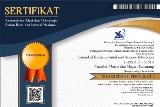Development of the Maze Chase Game in Guided Discovery Learning on Student Learning Outcomes
DOI:
https://doi.org/10.15294/jese.v4i1.638Keywords:
Maze Chase Game Media Development, Guided Discovery Learning, Cognitive Learning ResultsAbstract
Student learning outcomes have an important role in shaping students into careful and skilled individuals. As times progress, technological advances must be balanced with students' cognitive learning outcomes to create an advanced young generation. Improving the learning model towards deficiencies in the learning model such as deficiencies in the guided discovery learning model by considering technological advances aims to maximize student learning outcomes. The aim of the research was to determine the validity of the maze chase game media developed and the differences in the use of maze chase game media development in guided discovery learning between the experimental class and the control class. The development method in this development research is divided into three stages, namely define, design, and develop, while the differentiation test uses a quasi-experimental research design using the pretest-posttest control group design method. The research location is at SMP Negeri 23 Semarang with a sample of class VII A as the experimental class and class VII B as the control class at SMP Negeri 23 Semarang for the 2022/2023 academic year. The data collection technique uses purposive sampling technique and data collection uses test and non-test instruments in the form of questionnaires. The non-test instrument is used to determine the quality of the maze chase game media which shows valid quality, very good readability and very practical practicality. In the test data, there was an increase in N-Gain in the experimental class which was higher than the control class by 0.13 in the medium category. The results of the differentiation test using the Independent Sample T Test showed that there was a significant difference between the experimental class and the control class with a tcount>ttable value of 1.98.
